1.82" rain fell yesterday in the Twin Cities.
69 mph peak wind gust from yesterday's severe storms (MSP International Airport).
79 F. maximum temperature in the Twin Cities yesterday, shortly after midnight.
78 F. average high on June 11.
93 F. high on June 11, 2016.
June 12, 1917: The ice pack finally breaks up on Lake Superior near Duluth, one of the latest ever 'ice out' dates on record.
Cleaning Up From Sunday's Fast-Moving DerechoHow
will warming impact Minnesota? More flooding events. Flooding in places
that rarely see flooding - more "drainage floods" as opposed to rivers
overflowing their banks.
Check your homeowners policy - damage
from flooding probably isn't included. I see no strong scientific
evidence the warming well underway is sparking more tornadoes or hail,
at least not yet. Higher dew points in summer; we're seeing a longer
growing season and more erratic winter snows, but data linking high winds/big
hail with a warmer, wetter atmosphere is inconclusive at this time.
Tell
that to residents of Coon Rapids, where they had to call out the snow
plows! Sunday's squall line probably fit the definition of a rare
"derecho", with wind damage along a 250-mile swath or longer.
After
refreshing 60s yesterday we should see 80s today with a slight risk of
thunder. Storms become more numerous Tuesday as another hot front pushes
the mercury up to 90F. Wednesday's storms mark the leading edge of
cooler, drier air. By Sunday temperatures may hold in the upper 70s.
Enjoy any free A/C. I'm starting to suspect July will wind up stinking hot.
Photos from yesterday's severe thunderstorm outbreak:
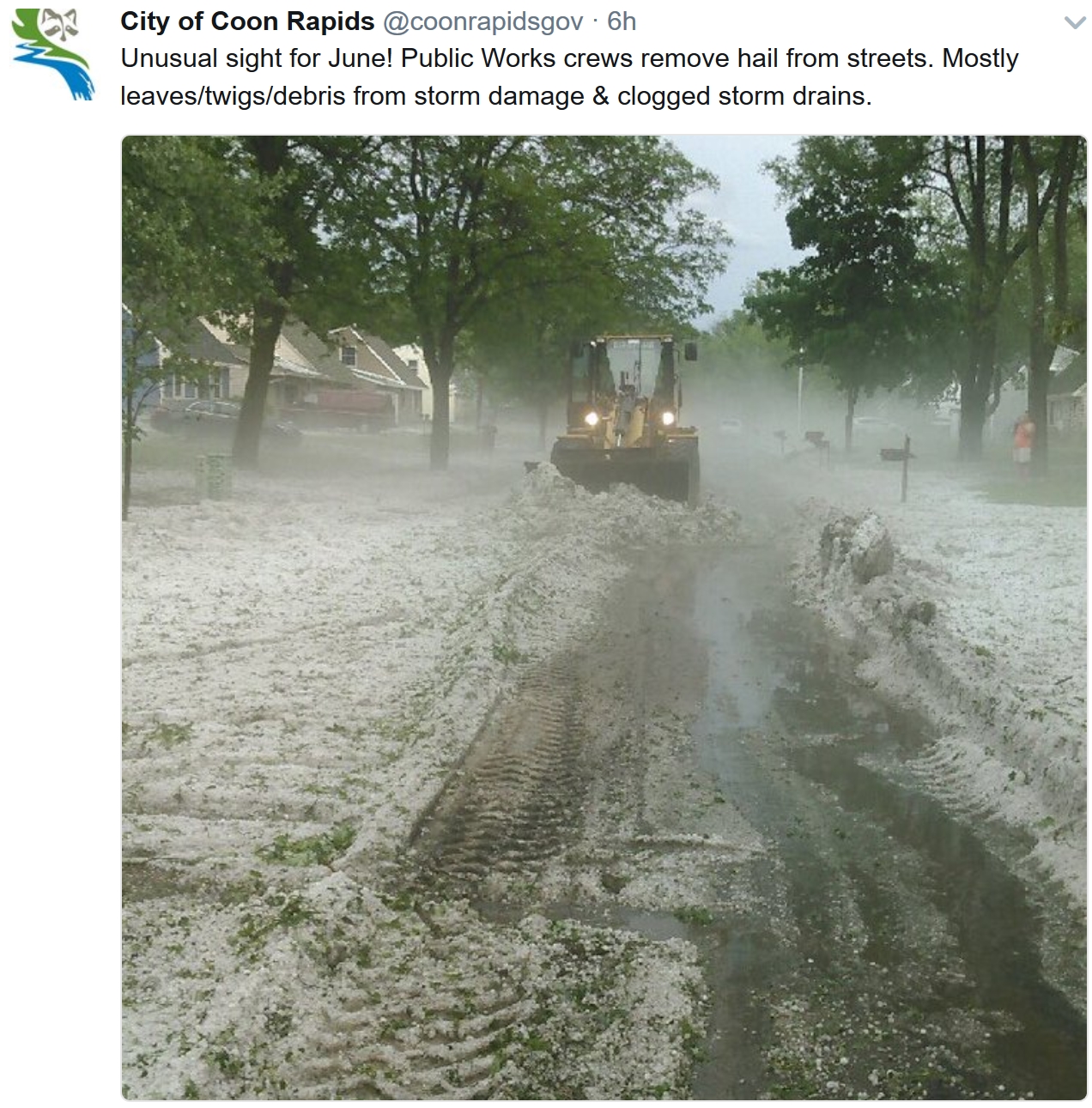
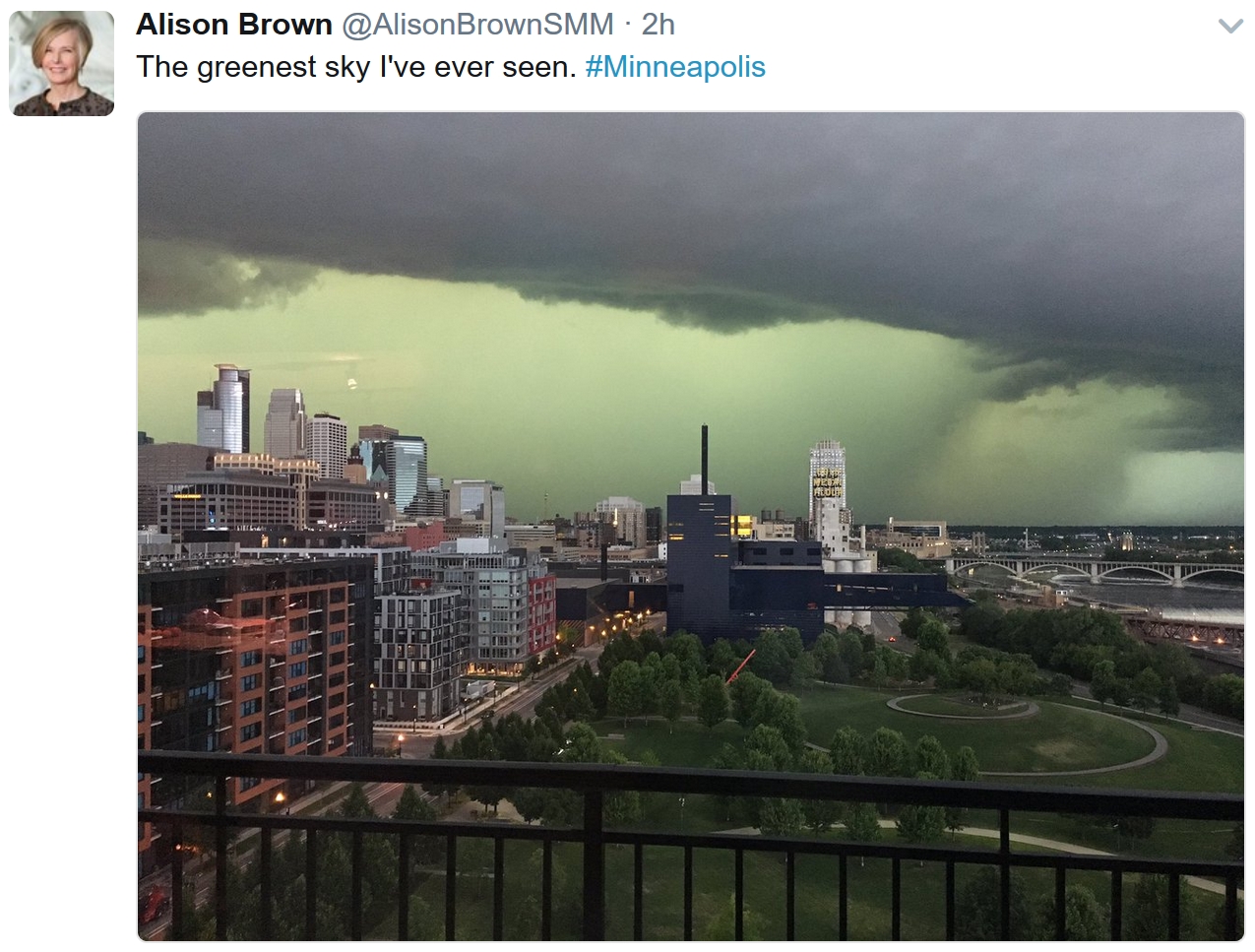
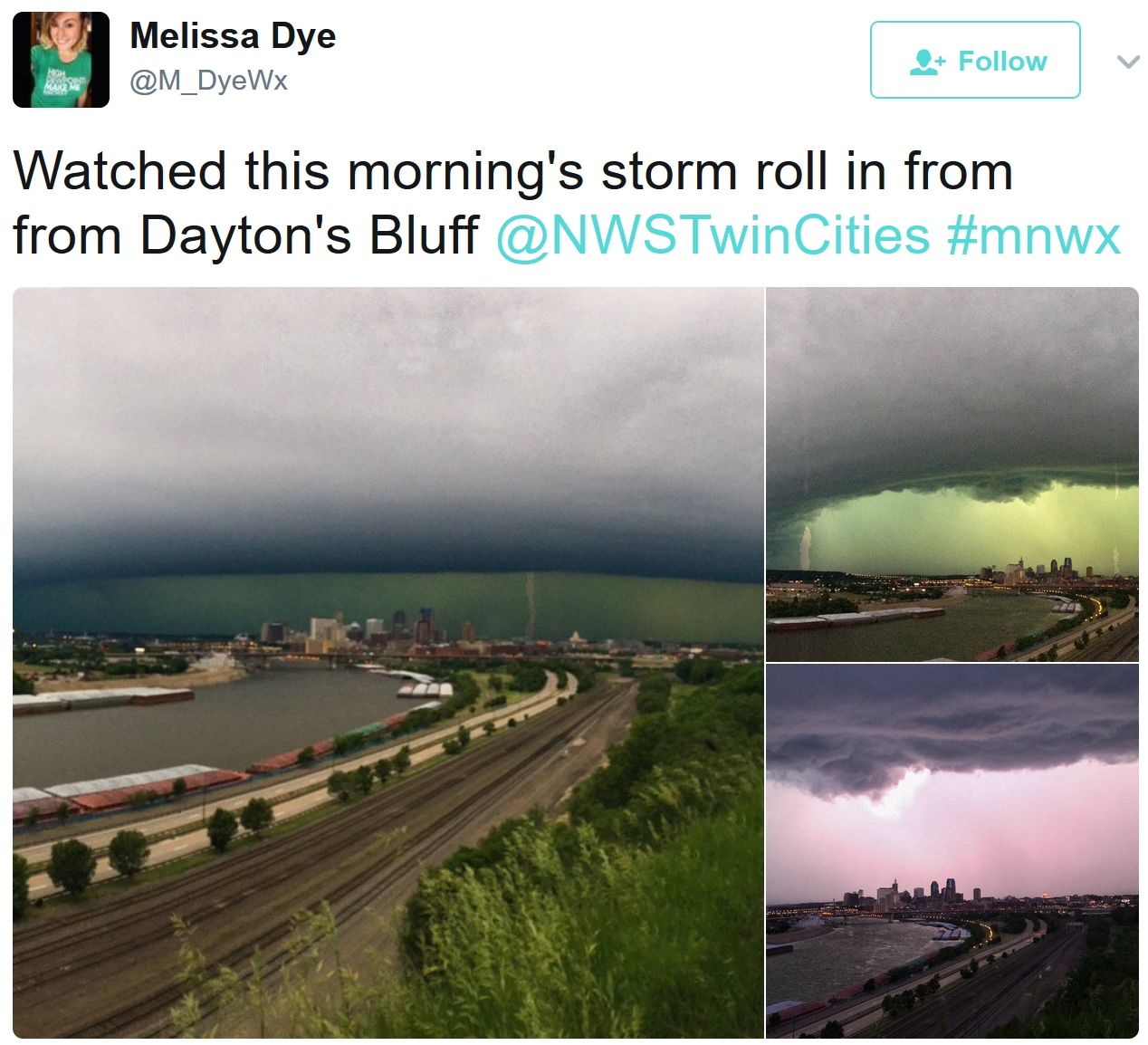
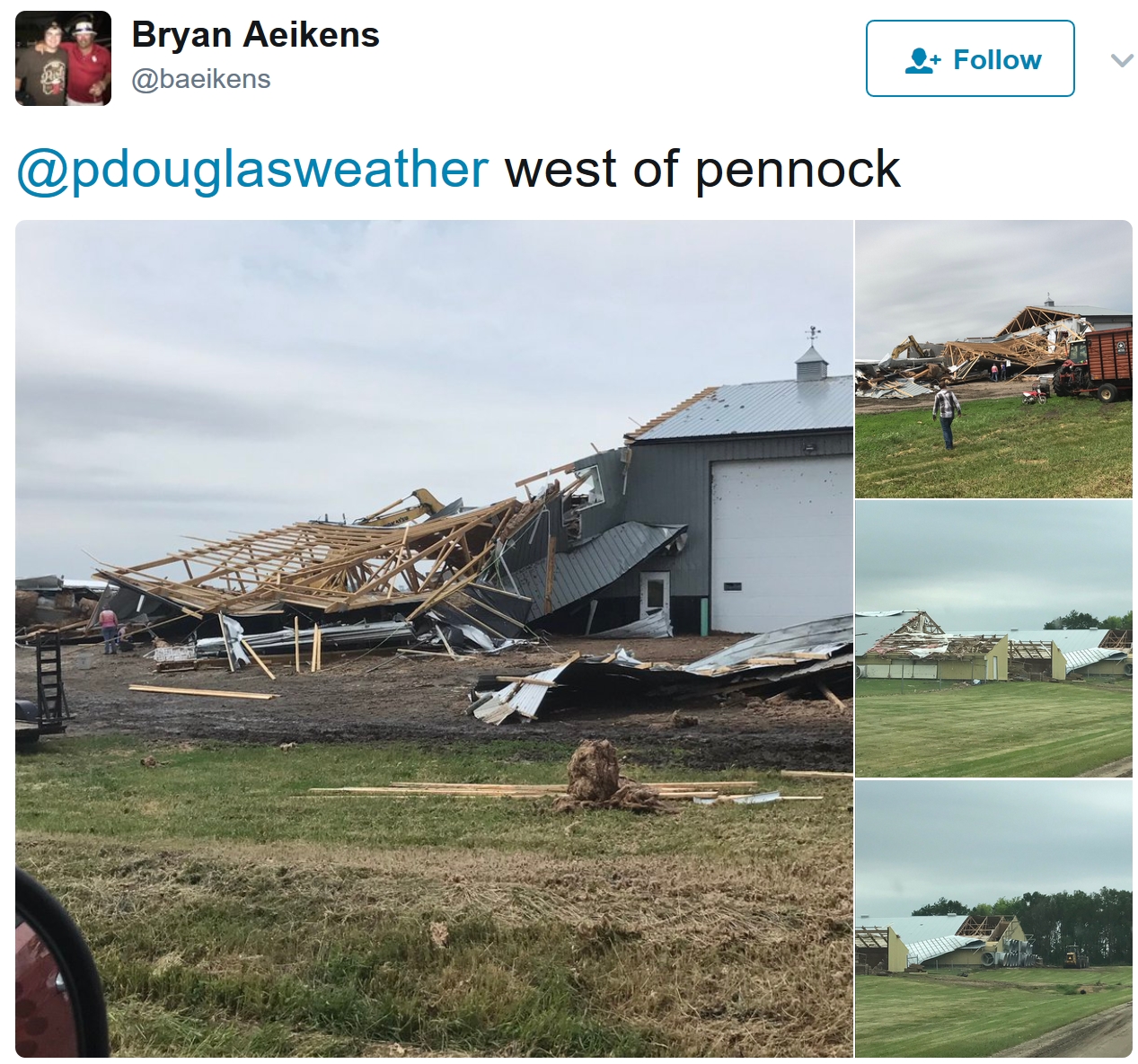
Bow Echo.
Whenever you see a line of thunderstorms "bowing out", the
configuration roughly resembling a horseshoe, it's a good indicator that
severe straight-line winds are a part of this storm complex. Such was
the case Sunday morning, with wind gusts to 70 mph and 2-3" diameter
hail. Some communities were hit harder than others (which is always the
case) - a reminder that June has a reputation for the most severe
weather of any month.
"A Nasty Storm".
The Star Tribune has more details on Sunday's severe weather episode across Minnesota and Wisconsin.
Was Yesterday's Squall Line a "Derecho"?
I believe the answer is yes, but I have yet to see the National Weather
Service confirm this. A derecho is a long-last, long-track severe
weather episode with straight-line wind damage for at least 250 miles.I
believe we met that criteria yesterday with wind damage from eastern
South Dakota into Wisconsin and Michigan. For a list of severe weather
reports
click here, courtesy of NOAA.
NOAA SPC has a complete list of Minnesota and Wisconsin hail and wind damage reports
here.
Derecho Climatology, Part 1.
Here is a map of some of America's most severe derechos. They are most
likely to develop over the Plains and Midwest, but especially extreme
derechos can survive the trip to the east coast of the USA. These
systems thrive on severe instability and moisture from the Gulf of
Mexico, both in short supply from the Rockies to the west coast, where
you may stand a better chance of spotting Elvis than a full-blown
derecho.
Derecho Climatology, Part 2.
On average central Minnesota experiences roughly 1 derecho every year.
That's the story fro Dallas and Oklahoma City to St. Louis, Chicago,
Louisville and Detroit. The climatological bulls-eye for derecho
formation is roughly Tulsa to Bentonville to Joplin, based on SPC data.
Monday Severe Risk.
The greatest potential for damaging hail and winds shifts west today,
into the Black Hills of South Dakota and eastern Wyoming, including
Sheridan and Cheyenne.
Excessive Rainfall Potential.
NOAA models are zeroing in on Boise, Bozeman, Rapid City and Pierre,
and Waterloo to La Crosse for the best chance of a few inches of rain
falling in a short period of time, conditions capable of supporting
flash flooding. Map: NOAA.
Strongest T-storms Sprout Over Northern Tier States.
Generally light to moderate showers spread into the Gulf Coast; the
greatest potential for storms capable of hail and damaging winds
(including isolated tornadoes) from Montana to Wyoming and the Dakotas
into the Midwest by Tuesday. The east coast heats up; within a few days
residents east of the Appalachians may be praying for a cooling shower.
84-hour NAM guidance: NOAA and Tropicaltidbits.com.
Gradual Cooling Trend.
Dew points reach the sticky 60s into Wednesday before a west breeze
pushes tropical air out of Minnesota later this week. Temperatures may
top 90F Tuesday if the sun is out for a few hours, but we'll all be
enjoying cooler, drier air by late week and next weekend. Twin Cities
ECMWF numbers: WeatherBell.
Wednesday Heat Index.
Much of American will be sweltering away this week, potentially
dangerous heat indices (100-105F) from San Antonio and Tulsa to Peoria
and Richmond. Washington D.C., a city of southern efficiency and
northern charm, will push 100F by midweek. Only the northern Rockies and
Pacific Northwest will escape the heat.
 Heat-Related Ailments.
Heat-Related Ailments.
Dry skin, rapid breathing and pulse, along with slurred speech and
disorientation are all symptoms of heat stroke, which can prove fatal if
not treated quickly and effectively. If in doubt, call 9-1-1.
 Dress for Hot Weather Success
Dress for Hot Weather Success. Although survival is probably a good place to start. Thanks to HealthTalkUMN at the University of Minnesota.
Heat Wave Expands Westward by Late June?
Confidence levels are low (because the 2 week GFS forecast has been all
over the map - literally) but the latest run tries to build a hot ridge
o f high pressure over the southwestern USA, Rockies and Plains; only
the Pacific Northwest and New England escaping sizzling heat. Place your
bets.
How To Keep Tabs on Atlantic Hurricanes.
The Economist
reports on a new constellation of low-orbiting satellites which may
provide the raw data necessary to do a better job accurately predicting
hurricane intensity (much harder to do than predict track). Here's an
excerpt: "...
Advances in automated sensors, both those that fly and
those that swim, are making it possible to gather more data from both of
these places. This season, for example, will be the first in which a
constellation of microsatellites called CYGNSS (Cyclone Global
Navigation Satellite System) watches storms as they roll in towards the
east coast. The eight-satellite swarm, which was launched in December,
listens for radio signals that come from GPS satellites directly above
it in space, and for the same signals when they have been reflected from
the ocean’s surface beneath the hurricane being studied. Differences
between the reflected signal and the original are a consequence of the
state of that surface, and CYGNSS can use them to infer wind conditions
there..."
Tropical Storm Arthur file image: International Space Station and NASA.
An Entire Town in the US is Sinking Because of Climate Change. It's actually due to a combination of land subsidence and rising seas, as explained at
Futurism: "
Isle
de Jean Charles, a small island in southeastern Louisiana’s bayous, is
drowning as the Gulf of Mexico rises. Twenty-nine homes remain, housing
100 people, but they are all being relocated because the flooding is
unstoppable. The island has already lost 98% of its land since 1955,
making it one of the most visible victims of climate change
— so far. The residents can either leave their homes or die in them,
and they are leaving. “Now there’s just a little strip of land left,”
resident Rita Falgout tells Quartz. “That’s all we have. There’s water all around us. I’m anxious to go...”
 The
Real Story Behind Elon Musk's $2.6 Billion Aquisition of Solar City,
and What It Means for Tesla's Future - Not To Mention the Planet's.
The
Real Story Behind Elon Musk's $2.6 Billion Aquisition of Solar City,
and What It Means for Tesla's Future - Not To Mention the Planet's. The longest headline on record? But more interesting background on what motivates Elon Musk, courtesy of
Fast Company: "...
These
roof tiles are the latest component of Musk’s larger plan to wean us
off fossil fuels. Inside the garage of each of these homes, he points
out, is a Tesla vehicle and next-generation Powerwall, the sleek
rechargeable battery Tesla developed in 2015 to store energy for
household use. During the day, the solar shingles can generate
electricity and recharge the Powerwall. After the sun goes down, the
battery takes over, providing power independent of the traditional
utility grid. “This is the integrated future. You’ve got an electric
car, a Powerwall, and a Solar Roof. It’s pretty straightforward,
really,” he says with a big shrug and a smile. “[This] can solve the
whole energy equation.” Musk’s announcement is about saving the planet.
But it’s also about saving SolarCity, the company his cousins, Peter and
Lyndon Rive—who are in the audience—launched with Musk’s support in
2006 to bring solar power to the masses..."
9.8 Million People Employed by Renewable Energy, According to New Report. Roughly 3 million of those jobs are in the USA. Here's a clip from
CNBC.com: "
Nearly
10 million people were employed in the renewable energy sector last
year, the International Renewable Energy Agency (IRENA) said on
Wednesday. IRENA's report, Renewable Energy and Jobs – Annual Review
2017, states that global renewable energy employment in 2016, excluding
large hydropower, hit 8.3 million. If direct employment in large
hydropower is included, that figure climbs to 9.8 million..."
File image: GreenTech Media.
We're Not in a Civil War, But We Are Drifting Toward Divorce. The urge to "self-segregate" probably won't end anytime soon, argues the author of a
National Review Op-Ed: "...
If
we seek to preserve our union, we’re left with a choice — try to
dominate or learn to tolerate? The effort to dominate is futile, and it
will leave us with a permanently embittered population that grows
increasingly punitive with each transition of presidential power. There
is hope, however, in the quest to tolerate. Our Constitution is built to
allow our citizens to govern themselves while protecting individual
liberty and providing for the common defense. It’s built to withstand
profound differences without asking citizens or states to surrender
their strongest convictions. We can either rediscover this federalism,
or we may ultimately take a third path — we may choose to separate..."
Concussion Expert Says Extent of Brain Damage in Youth Football Players "Took My Breath Away". Here's a clip from
ThinkProgress: "...
While
the impact of football on younger brains hasn’t been studied as
comprehensively, scientists at the Mayo Clinic Brain Bank last year
discovered evidence of CTE in 21 out of 66 brains
they studied that belonged to males who played contact sports when they
were young. Perhaps most alarmingly, they studied 198 brains in the
bank that had zero documented history of participating in contact
sports, and none of those brains showed signs of CTE. So while the
research is still in the early stages, the connection between contact
sports in youth and CTE later in life is pretty clear..."
Crispr May Cure All Genetic Disease - One Day. Here's an excerpt from
WIRED.com: "...
When
I think about where we are likely to see the biggest impacts in the
shortest amount of time, I really think it’s going to be in
agriculture,” she said. Plant breeders have always been geneticists at
heart. And with the precision and ease of Crispr, identifying and
separating out desirable traits has the potential to speed up new crop
development by several orders of magnitude. Agro-giants DuPont and
Monsanto have invested in Crispr licenses to accelerate their R&D
efforts toward creating crops that can withstand changing climates and
new disease and pest burdens. In test plots around the world gene edited
crops are already growing—from longer-lasting potatoes and
flood-resistant rice to drought-hardy corn and mildew-proof wheat, to
name just a few..."
Livemint has a very good explainer on the principals behind Crispr.
Here's What Will Happen To America's Dying Department Stores.
Call it Mall-apocalypse. Shopping habits and expectations are rapidly
changing; many people now relying on online options, argues a story at
Business Insider: "...
And
when department stores die, the mall itself sometimes follows, since
the former pays a large percentage of the building's rent. In a new report,
Credit Suisse analysts expect that 20% to 25% of malls — about 220 to
275 shopping centers — will shutter over the next five years, largely
due to department store closures. Retail experts attribute the
traditional mall's decline to changing habits of American consumers, who increasingly prefer to spend money online or on experiences rather than objects. Department stores at malls of the future have an opportunity to fulfill other community needs besides commerce, June Williamson ,
an architecture professor at the City College of New York and an author
of "Retrofitting Suburbia," tells Business Insider. She says the US
simply has built too many malls (and thus, department stores)..."
Photo credit: Rolling Acres Mall Nicholas Eckhart
Bear Breaks Into House, Plays the Piano but Not Very Well. I give him credit for trying. Here's an excerpt of a funny tale at The Washington Post: "Katie
Hawley was not home when the black bear toured her house in Vail,
Colo., but it had no problem getting in. She had accidentally left
the kitchen window unlocked, and the bear slid it right open, as if it
were familiar with the model. In the living room, as security camera
footage would later reveal, the bear took in the views, loped around the
coffee table and briefly stood on its hind legs to play the piano. The
animal was less adept with that human-designed apparatus: The music was
not very good. This was no Bear-thooven. Its “Clair de Lune” was more
“Bear de Lune”: one atonal chord. Vail police, accustomed to mediating
bear-human encounters in the mountain town, declared it “unbearable” and “grizzly...”
Video credit: "
A Colorado woman called police when she came home to find her house trashed. Then they watched the surveillance tape." (The Washington Post)


TODAY: Some sun, stray storm possible. Winds: E 5-10. High: 84
MONDAY NIGHT: Partly cloudy and muggy, isolated thunderstorm. Low: 70
TUESDAY: Steamy and hot, more numerous T-storms. Winds: SE 10-20. High: near 90
WEDNESDAY: T-storms likely, have a Plan B. Winds: SW 10-20. Wake-up: 72. High: 85
THURSDAY: Partly sunny, breathing easier. Lower humidity. Winds: W 10-15. Wake-up: 64. High: 84
FRIDAY: Mix of clouds and sun, comfortable. Winds: NW 8-13. Wake-up: 65. High: 83
SATURDAY: Peeks of sun, passing T-shower. Winds: NW 10-20. Wake-up: 63. High: near 80
SUNDAY: Intervals of sun, a bit cooler. Winds: NE 7-12. Wake-up: 60. High: 78
Climate Stories...
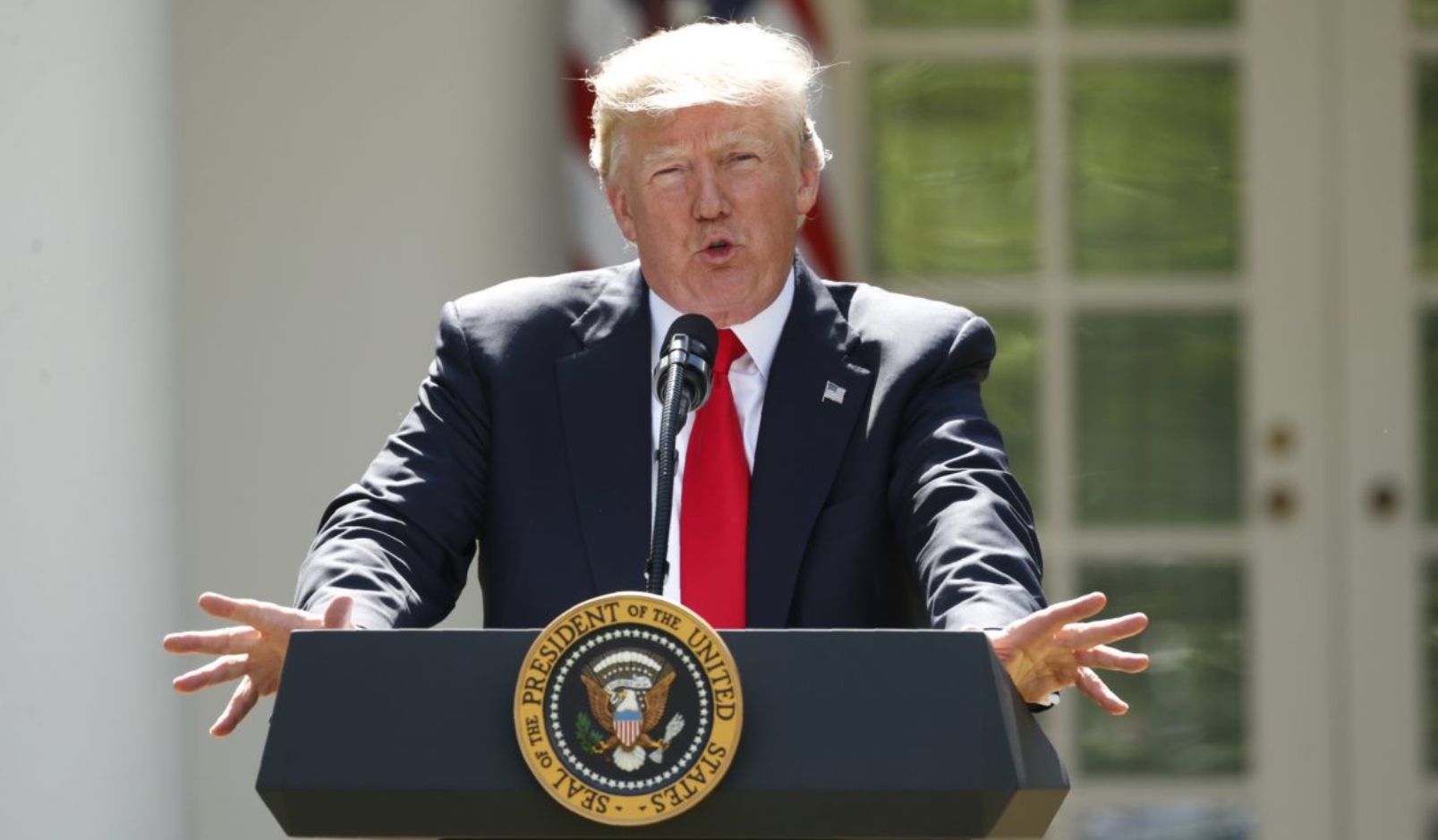 Trump Wages Battle Against Regulations, Not Climate Change.
Trump Wages Battle Against Regulations, Not Climate Change. Some interesting spin from
PBS NewsHour; here's the intro: "
While
President Donald Trump’s beliefs about global warming remain something
of a mystery, his actions make one thing clear: He doesn’t consider it a
problem for the federal government to solve. Trump’s recent decision to
pull out of the Paris climate deal
was just his latest rapid-fire move to weaken or dismantle federal
initiatives to reduce carbon emissions, which scientists say are heating
the planet to levels that could have disastrous consequences. Trump is
waging war against efforts to curb U.S. dependence on fossil fuels. He’s
done that through executive orders targeting climate change programs
and regulations, massive proposed spending cuts and key appointments
such as Scott Pruitt as chief of the Environmental Protection Agency..."
Photo credit: "
U.S.
President Donald Trump announces his decision that the United States
will withdraw from the Paris Climate Agreement, in the Rose Garden of
the White House in Washington, D.C., on June 1, 2017." Photo by Kevin Lamarque/Reuters.
Iowa Teaching Standards Don't Say Humans Cause Climate Change, But... An article at
The Des Moines Register explains: "
At
first, people who reject predominant scientific findings that humans
are the main cause of climate change may be glad that new public-school
science standards don’t require teachers to teach that. But if
inquiry-based teaching guides under development in the Iowa K-12 Climate
Science Education Initiative are used, students may reach that
determination on their own, educators say. The Climate Science Education Initiative,
a project of the University of Iowa’s Center for Global and Regional
Environmental Research and College of Education, will help teachers
apply in class Next Generation Science Standards that do not take the step of telling students what to think about climate change..."
Photo credit: "
Iowa is seeing more floods as a result of climate change, yet has little idea of the price tag for needed protection."
Aaron Young/The Register.
Once Again Climate Change Cited as Trigger for War.
A recent report highlights 12 epicenters worldwide, where a rapidly
changing climate could contribute to destabilization and conflict. Scientific American has details: "...Many
of the risk epicenters stem from resource shortages and dislocated
populations, but the experts also consider an increased likelihood of
nuclear war, more pandemics and tensions in the Arctic. Any one of those
factors is enough to cause serious problems, but together they threaten
to undermine the international order, said Francesco Femia, one of the
authors of the report, titled “Epicenters of Climate and Security: The
New Geostrategic Landscape of the Anthropocene.” “The humanitarian
effects of [climate change] are massive,” he said. “But what we’re
saying is that those humanitarian consequences are likely to spill over
into broader security problems that speaks to the heart of how the world
organizes itself...”
Photo credit: "
The Mosul Dam in Iraq." Credit:
United States Army Corps of Engineers Wikimedia Commons

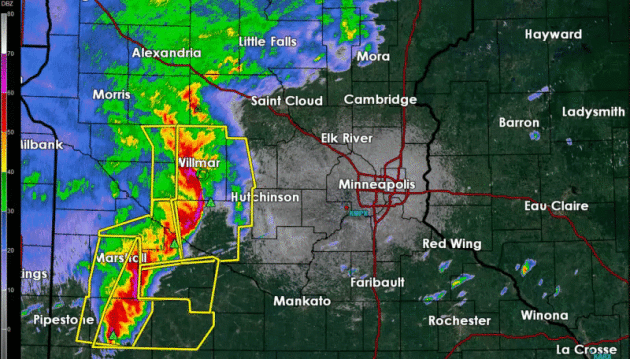

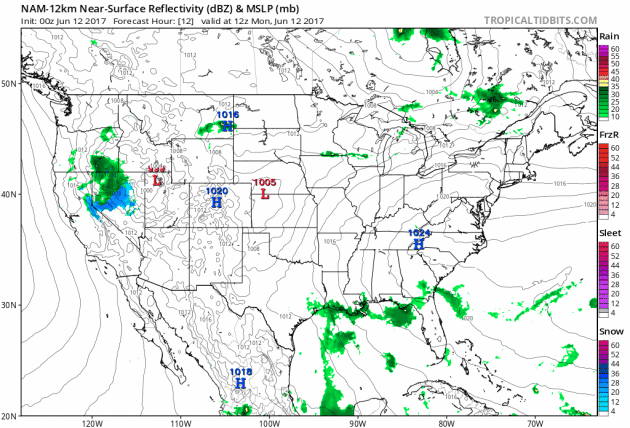
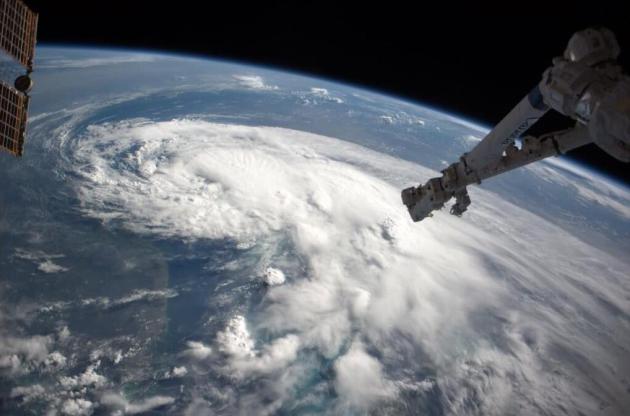


No comments:
Post a Comment